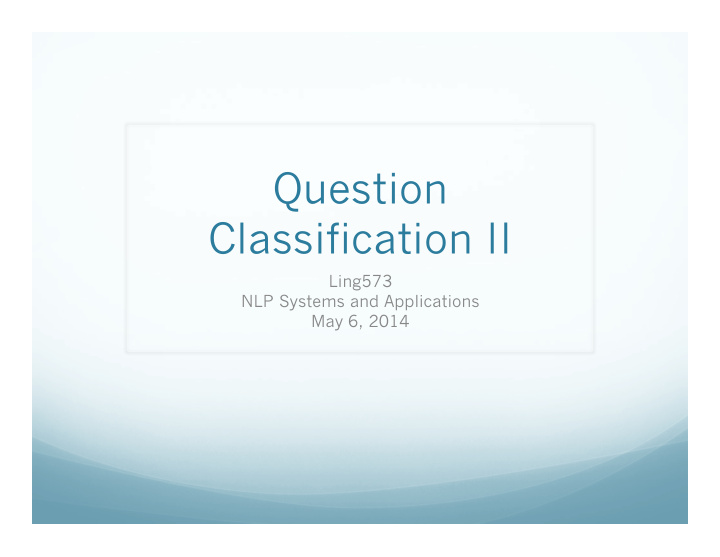



Question Classification II Ling573 NLP Systems and Applications May 6, 2014
Roadmap Question classification variations: Sequence classifiers Sense information improvements
Enhanced Answer Type Inference … Using Sequential Models Krishnan, Das, and Chakrabarti 2005 Improves QC with CRF extraction of ‘informer spans’ Intuition: Humans identify Atype from few tokens w/little syntax Who wrote Hamlet? How many dogs pull a sled at Iditarod? How much does a rhino weigh? Single contiguous span of tokens How much does a rhino weigh? Who is the CEO of IBM?
Informer Spans as Features Sensitive to question structure What is Bill Clinton’s wife’s profession? Idea: Augment Q classifier word ngrams w/IS info Informer span features: IS ngrams Informer ngrams hypernyms: Generalize over words or compounds WSD? No
Effect of Informer Spans Classifier: Linear SVM + multiclass Notable improvement for IS hypernyms Better than all hypernyms – filter sources of noise Biggest improvements for ‘what’, ‘which’ questions
Perfect vs CRF Informer Spans
Recognizing Informer Spans Idea: contiguous spans, syntactically governed Use sequential learner w/syntactic information Tag spans with B(egin),I(nside),O(outside) Employ syntax to capture long range factors Matrix of features derived from parse tree Cell:x[i,l], i is position, l is depth in parse tree, only 2 Values: Tag: POS, constituent label in the position Num: number of preceding chunks with same tag
Parser Output Parse
Parse Tabulation Encoding and table:
CRF Indicator Features Cell: IsTag, IsNum: e.g. y 4 = 1 and x[4,2].tag=NP Also, IsPrevTag, IsNextTag Edge: IsEdge: (u,v) , y i-1 =u and y i =v IsBegin, IsEnd All features improve Question accuracy: Oracle: 88%; CRF: 86.2%
Question Classification Using Headwords and Their Hypernyms Huang, Thint, and Qin 2008 Questions: Why didn’t WordNet/Hypernym features help in L&R? Best results in L&R - ~200,000 feats; ~700 active Can we do as well with fewer features? Approach: Refine features: Restrict use of WordNet to headwords Employ WSD techniques SVM, MaxEnt classifiers
Head Word Features Head words: Chunks and spans can be noisy E.g. Bought a share in which baseball team ? Type: HUM: group (not ENTY:sport) Head word is more specific Employ rules over parse trees to extract head words Issue: vague heads E.g. What is the proper name for a female walrus? Head = ‘name’? Apply fix patterns to extract sub-head (e.g. walrus) Also, simple regexp for other feature type E.g. ‘what is’ cue to definition type
WordNet Features Hypernyms: Enable generalization: dog->..->animal Can generate noise: also dog ->…-> person Adding low noise hypernyms Which senses? Restrict to matching WordNet POS Which word senses? Use Lesk algorithm: overlap b/t question & WN gloss How deep? Based on validation set: 6 “Indirect hypernyms” Q Type similarity: compute similarity b/t headword & type Use type as feature
Other Features Question wh-word: What,which,who,where,when,how,why, and rest N-grams: uni-,bi-,tri-grams Word shape: Case features: all upper, all lower, mixed, all digit, other
Results Per feature-type results:
Results: Incremental Additive improvement:
Error Analysis Inherent ambiguity: What is mad cow disease? ENT: disease or DESC:def Inconsistent labeling: What is the population of Kansas? NUM: other What is the population of Arcadia, FL ? NUM:count Parser error
Question Classification: Summary Issue: Integrating rich features/deeper processing Errors in processing introduce noise Noise in added features increases error Large numbers of features can be problematic for training Alternative solutions: Use more accurate shallow processing, better classifier Restrict addition of features to Informer spans Headwords Filter features to be added
Recommend
More recommend